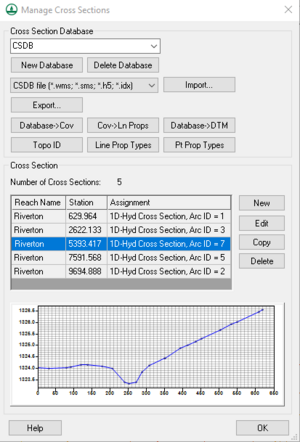WMS:Managing Cross Sections: Difference between revisions
No edit summary |
|||
| Line 1: | Line 1: | ||
For the new 1D Hydraulic Cross Section coverage, the cross section geometry is stored in text database file on disk. When extracting cross sections they are saved to a new (or existing) database file. This database was the basis for the development of the cross section data in the ArcHydro data model. Cross sections in the database can be used for the development of hydraulic models such as HEC-RAS. | For the new 1D Hydraulic Cross Section coverage, the cross section geometry is stored in a text database file on disk. When extracting cross sections they are saved to a new (or existing) database file. This database was the basis for the development of the cross section data in the ArcHydro data model. Cross sections in the database can be used for the development of hydraulic models such as HEC-RAS. | ||
Extracting cross sections from a TIN is not the only way cross section geometry can be created. It is also possible to enter surveyed cross sections, however in order to use them in WMS for floodplain delineation, or modeling of any kind they must be georeferenced (tied to a geographic location). Further cross sections can be edited, merged, etc. | Extracting cross sections from a TIN is not the only way cross section geometry can be created. It is also possible to enter surveyed cross sections, however in order to use them in WMS for floodplain delineation, or modeling of any kind they must be georeferenced (tied to a geographic location). Further cross sections can be edited, merged, etc. | ||
| Line 11: | Line 11: | ||
*Topo ID – a topographic identifier and description that identifies where the cross section database was derived from. Create a new Topo ID for each database. | *Topo ID – a topographic identifier and description that identifies where the cross section database was derived from. Create a new Topo ID for each database. | ||
*Line Prop Types – By default WMS uses only a Material ID, but other properties could be defined for general use (they will not immediately be used by supported hydraulic models). | *Line Prop Types – By default, WMS uses only a Material ID, but other properties could be defined for general use (they will not immediately be used by supported hydraulic models). | ||
*Point Prop Types – By default WMS uses thalweg, left bank, and right bank but other point properties could be defined for general use. | *Point Prop Types – By default, WMS uses thalweg, left bank, and right bank but other point properties could be defined for general use. | ||
[[File:CsDbManagement.jpg|thumb|none|left|300 px|Cross Section Database ''CsDb Management'' dialog.]] | [[File:CsDbManagement.jpg|thumb|none|left|300 px|Cross Section Database ''CsDb Management'' dialog.]] | ||
Revision as of 22:38, 4 May 2020
For the new 1D Hydraulic Cross Section coverage, the cross section geometry is stored in a text database file on disk. When extracting cross sections they are saved to a new (or existing) database file. This database was the basis for the development of the cross section data in the ArcHydro data model. Cross sections in the database can be used for the development of hydraulic models such as HEC-RAS.
Extracting cross sections from a TIN is not the only way cross section geometry can be created. It is also possible to enter surveyed cross sections, however in order to use them in WMS for floodplain delineation, or modeling of any kind they must be georeferenced (tied to a geographic location). Further cross sections can be edited, merged, etc.
The Manage Cross Sections command in the River Tools menu allows creating a new database or opening an existing database to add geometries, edit existing ones, and provide proper georeferencing information. It is also possible to open a cross section database using the Open command from the File menu.
Cross Section Database Definition
When setting up a new database the following attributes can be defined as shown in the CsDb dialog below:
- Topo ID – a topographic identifier and description that identifies where the cross section database was derived from. Create a new Topo ID for each database.
- Line Prop Types – By default, WMS uses only a Material ID, but other properties could be defined for general use (they will not immediately be used by supported hydraulic models).
- Point Prop Types – By default, WMS uses thalweg, left bank, and right bank but other point properties could be defined for general use.
The Cross Section Database Management dialog can also:
- Create a new cross section.
- Edit, copy, or delete an existing cross section.
- Insert an entire database or merge databases together,
- Convert a cross section database to a coverage. The georeferencing of cross sections must be provided for the cross section to be included in the coverage.
- Create a digital terrain model form the cross section geometry.
- Converting the coverage to line properties.
Related Topics
WMS – Watershed Modeling System | ||
|---|---|---|
| Modules: | Terrain Data • Drainage • Map • Hydrologic Modeling • River • GIS • 2D Grid • 2D Scatter |  |
| Models: | CE-QUAL-W2 • GSSHA • HEC-1 • HEC-HMS • HEC-RAS • HSPF • MODRAT • NSS • OC Hydrograph • OC Rational • Rational • River Tools • Storm Drain • SMPDBK • SWMM • TR-20 • TR-55 | |
| Toolbars: | Modules • Macros • Units • Digitize • Static Tools • Dynamic Tools • Drawing • Get Data Tools | |
| Aquaveo | ||

